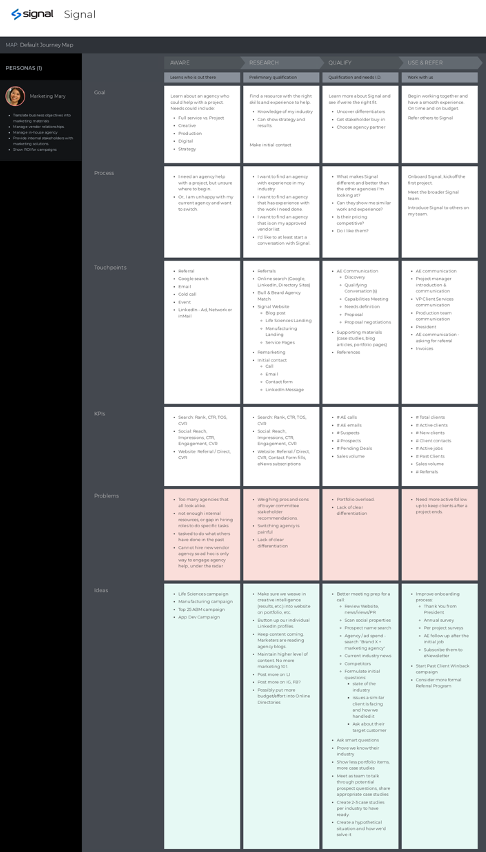
A customer journey map (CJM) is an essential tool for improving your team’s understanding of the customer and enhancing the customer experience. Creating a comprehensive, customer-centric view helps everyone understand the customer’s needs, pain points and expectations at each stage of the customer journey. With this understanding, businesses can identify areas for improvement and streamline and optimize customer experiences to increase customer satisfaction, loyalty and advocacy.
Key Benefits of Creating a Customer Journey Map
Understand Your Customers Better
Customer journey maps help you gain a better understanding of your target audience by identifying the various touchpoints that your customers interact with during their journey. By understanding the customer’s pain points and motivations, you can tailor your marketing strategies to resonate with your target audience, leading to better engagement and increased conversion rates.
Create a Consistent Customer Experience
Consistency in customer experience is key to building long-term customer relationships. A customer journey map helps you identify the ideal customer experience and ensure that all touchpoints deliver a consistent experience across all channels. By creating a cohesive and seamless customer experience, you can improve customer loyalty and retention rates.
Get Ahead of the Competition
By mapping out the customer journey, you can identify gaps in the market and identify areas where the competition is weaker. By truly understanding the customer experience, you can tailor your strategy to address any unmet needs, providing a competitive advantage.
Foster a Culture of Customer-Centricity
Creating customer journey maps is the foundation for building a customer-centric culture within your organization. In doing so, you can create a customer-centric business model that is more responsive to customer needs, leading to increased loyalty, customer retention, and ultimately revenue growth.
How to Get Started
After you create a customer persona, your team should have a clear understanding of the specific individual you’re trying to target. This persona document will allow everyone on your team to be in sync on demographic details (e.g., age, gender, income, occupation), geographic location, and psychographic information (e.g., beliefs, politics, religion, etc.).
Now that the persona confirms exactly who we’re targeting, we need to define how that customer may interact with our company so we can understand and shape their experience. CJMs do just that. A CJM is a diagram that illustrates each stage of a customer’s journey across various touchpoints.
When you create a CJM, you’ll need to determine what customer goal you want to focus on to determine where the customer journey begins and ends. The scope of the visual representation of the experience depicted in a CJM may be very broad – possibly starting before the customer becomes aware of your business, through your marketing and sales process to becoming a customer advocate. Or, a CJM focus may be narrow and only include on a specific part of the customer journey, such as ordering a specific product on your website.
The structure of CJMs can vary to fit the specific needs of the customer journey being mapped. However, they all focus a single persona as a starting point. With this detailed description of demographic information, behavior patterns and other characteristics, you can put yourself in the shoes of your target customer.
Typical Elements of a Customer Journey Map

Stages: Stages are the backbone of a CJM and help organize the customer journey
into steps that represent customer interactions. Stages typically follow your sales funnel (e.g., awareness, consideration, preference, action and loyalty) and are typically divided into three phases: pre-purchase, purchase and post-purchase.
Touchpoints: Within each stage, there are various touchpoints where the customer interacts with the organization. These touchpoints can be physical, digital or emotional, and may include things like visiting a website, social media, contacting customer service or receiving a product delivery.
Actions/Process: The fourth element is the actions taken by the customer at each stage. This includes behaviors, emotions and needs that are associated with each interaction.
Pain points/Problems: Pain points or areas of frustration that the customer experiences at each stage. These pain points can include things like long wait times, confusing instructions, or poor customer service.
Additional Elements to Consider
At Signal, we advocate for incorporating the following elements to enhance your marketing efforts and overall customer experience:
KPIs: Identify key performance indicators to measure each touchpoint’s effectiveness. For example, if Google search is a touchpoint during the awareness stage, relevant KPIs may include search rank, click-through rate (CTR), and time spent on site.
Ideas/Opportunities: Lastly, explore ideas and identify opportunities for improvement at each stage. This involves finding solutions to address pain points, enhance the customer experience, and improve overall satisfaction.
Best Practices When Getting Started
- Gather data: Collect data from various sources, such as customer surveys, feedback, website analytics, CRM systems and social media. This data should provide insights into customer touchpoints, behaviors, pain points and emotions at different stages of their journey.
- Share and collaborate: Marketers should never create a CJM in a vacuum. Share it with your team and encourage collaboration across cross-functional stakeholders.
- Monitor and iterate: The customer journey is not static, so regularly review and update your map to reflect changes in customer behavior and market dynamics. Use ongoing feedback and data to refine the map and make continuous improvements.
Parting Thoughts
Customer journey maps are essential tools for modern marketing strategies. By truly understanding your customers’ journeys, you can serve them better, provide consistency in their experience, stand out from competitors, and establish a culture centered around customers. Companies that invest in creating CJMs will be well-positioned to deliver exceptional customer experiences and drive business growth.
If you want to learn more and see real-life examples, Let’s Talk.






